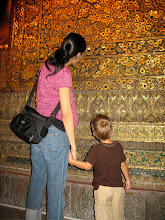This is the National Assembly building of Bangladesh, the building where Parliament meets. It was designed by Louis Kahn back when Dhaka was the capital of East Pakistan. Construction languished for a while during the war for independence, but the building was finally finished in 1982.
I had passed by the building a number of times, just driving around Dhaka, and was never wildly impressed by it. From a distance, it looked like a typically heavy concrete government building from the 1960s or 1970s. The geometric windows seemed quirky, to be sure, but nothing suggested that this was a building of global stature.
Then Chris and I saw the movie My Architect, made by Louis Kahn's son, Nathaniel Kahn. The movie is a documentary about the (illegitimate) son's attempt to know his father better, partly by visiting the buildings he designed. Most of the buildings are easily accessible -- California, Texas, Pennsylvania, Connecticut -- but the travels eventually lead to a trip to India and Bangladesh.
The National Assembly building is widely considered to be Kahn's greatest work. People travel to Dhaka solely to see this building. It has been named one of the seven wonders of the architectural world and called a modern masterpiece by one critic who said, "it is possibly without parallel in the modern world." Clearly, we had been overlooking a treasure in our own backyard.
We arranged for a tour of the building. We drove in through the gates and got out of the van near the building's entrance. And when I finally saw it up close for the first time... it's hard to describe how I felt. The building has a lightness to it that is somehow contagious, and I too felt light, almost giddy. I realized that I was smiling. I was... delighted.
Needless to say, it's not a concrete hulk at all. These photos do not even begin to do it justice, but somehow, Kahn used concrete to create something that is the opposite of concrete, something light and ethereal and peaceful. It's in the middle of a lake, appropriately for this country of water, surrounded by solid brick buildings, and somehow it rises out of the water like it just belongs there, organic and natural and serene.
And the inside... the inside is the best part. I don't have any photos, because cameras are not allowed inside. However, you can see photos here and here and here. The inside is the most clever, the wittiest, the most creative and imaginative thing I have ever seen. The angles, the geometry, the way the light comes in, the metaphors, the enormous concrete umbrella that spans the main assembly hall, looking like it's just floating in air... it has to be seen. I loved all of it.
This building is a reason to visit Dhaka... besides, you know, coming to see us. Come and visit and see.



























